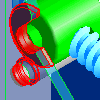Analyze assemblies for interference among components.

In an assembly, two or more components cannot occupy the same space at the same time. To detect such errors, you can analyze assemblies for interference. Where components overlap, interference is temporarily displayed as a solid.
You can check for interference among components within a single subassembly or selected group of components or between two sets of components. If interference is detected, an interference solid is temporarily created to illustrate where the interference occurs. You can then modify components to eliminate the interference.
Resolving interference between components
The interference volume displays as a solid. Following the analysis, you can edit components to remove the interference.
- Lists parts or subassemblies that interfere.
- Tells x, y, z coordinates of the centroid of the interference volume.
- Lists the volume of the interference.
- Provides options to filter out the following interference types:
- General
- Threads and matched threads
- Non-threaded content center parts
- AnyCAD reference components
- Provides options to Ignore and Un-ignore items.
- Double clicking on an interference allows you to graphically focus on an individual interference region by zooming into a specified collision.
- Details information about mismatched thread interferences.
Analysis time
The time required to analyze interference depends on the number and complexity of the components selected. For complex analyses where processing time is long, a message displays and you can stop the analysis. Plan complex analyses to run at the end of the day or select fewer components to analyze.
Strategy for analyzing interference
Analysis takes longer when multiple components and components with complex topology are involved. Analyze a few components at a time, such as the components close to one another. When you add another component, analyze again if you suspect components interfere, selecting the components that are close. To correct small interference problems throughout the design process, reposition and redesign components regularly.
To check interference in a large subassembly or an entire assembly, schedule the analysis to run after normal working hours.
Avoiding interference between components
When you design new parts, create them in the assembly, sketching on faces of adjacent components. Project geometry from other component edges for use in sketches. If exact size of a component depends on its placement in the assembly, leave features undimensioned and size the part by constraining it to adjacent components. Remember to define features as adaptive in the part environment, and then set parts and subassemblies as adaptive in the assembly.